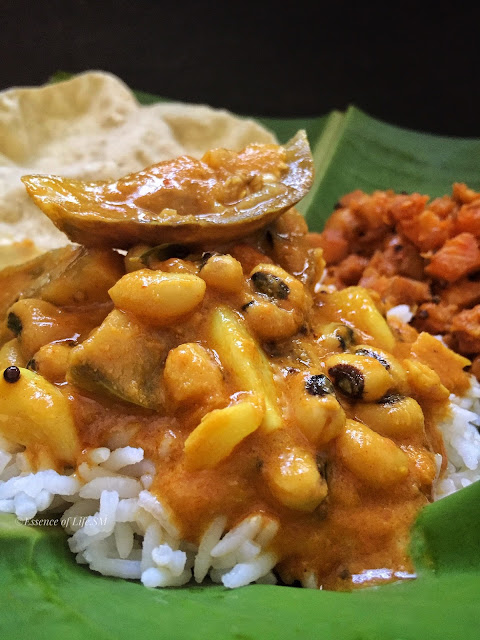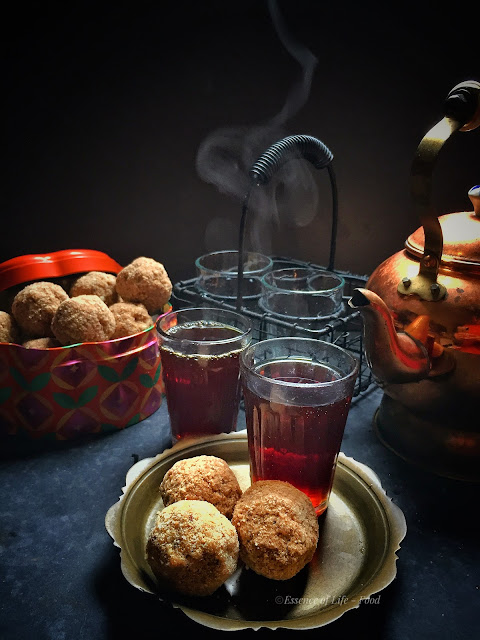THATTA PAYIRU KATHIRIKKAI KUZHAMBU
 |
| THATTA PAYIRU KATHIRIKKAI KUZHAMBU |
Yet another recipe from my hometown, Coimbatore. A unique Kongu style Kuzhambu, which I learnt from my house help - Hamsa Akka. She would term it as "Aatti Vacha Thattam Payiru Kulambu". Well, Thatta Payiru & Kathirkkai Kuzhambu is nothing but a Curry made with a combination of Black-eyed Peas and Eggplant(Brinjal). Cow Peas/Black-eyed Peas, colloquially called Thatta Payiru is one common gram variety used in Kongu Cuisine along with Green Grams(Pachai Payiru) & Horse Grams(Kollu Paruppu). The variety of Thatta Payiru we get in Coimbatore is slightly brown in colour and smaller in size. As I couldn't get hold of this variety locally, I have used the Vellai Payiru(which belongs to the same family) alias the Cow Peas or the Black-eyed Peas.
This Thatta Payiru Kuzhambu has two distinct specialities of its own.
- A portion of soaked & cooked Thatta Payiru is ground and added into the Kuzhambu(Curry) &
- Mainly they add a bit of Castor Oil(Velakkennai) while cooking Thatta Payiru.
The laxative nature of Castor Oil aids in digestion & also keeps gastrointestinal problems at bay. Most of the Beans, Lentils & Pulses(Except Green Gram & Moong Dhal) contains, Raffinose & Oligosaccharide, which is a complex sugar that the body can not break down fully, which causes trouble in digesting & also cause gas. A drop of Castor oil while cooking Thatta Payiru solves this issue.
Hamsa Akka grinds the grated coconut & spices for this curry in an Aattangkal and not Ammikkal. She says, "Appathaan Kulambu Nalla Irukkum" only then the curry would taste well. Aattangkal is the traditional type of mortar & pestle specifically used for grinding Idli Dosa Batter. Whereas Ammikkal is a kind of flat lay mortar & pestle used for grinding masalas, spices, chutneys etc.,
And she insists upon
- Grinding the coconut, spices & thatta payiru in Aattaangkal(Mortar & pestle).
- Then using Shallots and not Onions &
- To temper the curry in Gingelly Oil(Nallennai).
I still remember the way she peels the shallots & garlic, all using her nails, no knife whatsoever. Overall enthusiasm which gets into her when we ask her to cook, is something I can never forget. The instructions would be given out like a commentary as if she is running a cooking show flows throughout the process. It's what I still remember with these recipes. Ironically I hadn't jotted it down in my recipe books then. And finally, she would add, Suda Suda Kolamba Sappatula Oothi, Konjoondu Nei vittu Sappidu!!! (Pour hot Curry to the Rice and eat with a dollop of Ghee).Thanks, Hamsa Akka!!!
But my unproclaimed skill with an Ammikkal & Aattangkal, I have always ground the masala paste in a Mixer. And you can even substitute whole Coriander Seeds and Dry Red Chillies with Coriander Powder & Red Chilli Powder. But the above form of the ingredients yields an authentic taste to this Kongu style curry.
For more Recipes from KONGU CUISINE, Click here...
Cuisine - Kongu Cuisine(South India)
Course - Side Dish
Spice Level - Medium
Difficulty - Easy
Serves - 3-4
Author - SM
Soaking Time - 6-8 Hours/Overnight
Preparation Time - 5 -10 Minutes
Cooking Time - 25 - 30 Minutes
HOW TO COOK KONGU STYLE THATTA PAYIRU KATHIRIKKAI KUZHAMBU

THATTA PAYIRU KATHIRIKKAI KUZHAMBU

INGREDIENTS:
For Thatta Payiru Kathirkkai Kuzhambu:
Thatta Payiru(Cow Peas/Black Eyed Peas) - 1/2 CupEggplant/Brinjal(Kathirikkai) - 4-5 Nos.
Gingelly Oil - 2-3 Tablespoons
Mustard Seeds - 1/2 Teaspoon
Dry Red Chillies - 2 Nos.
Curry Leaves - 2 Sprigs
Shallots - 12- 15 Nos.
Garlic - 6-8 Cloves
Tomato - 1 No.
Tamarind - 1/2 a lime sized
For the Masala Paste:
Coconut - 1/2 CupShallots - 5-6 Nos.
Cumin Seeds - 1/2 Teaspoon
Coriander Seeds - 11/2 Teaspoon
Dry Red Chillies - 3-4 Nos.
METHOD:
To Soak & Cook the Thatta Payiru Cow Peas(Black-eyed Peas):
- Clean, Wash & Soak the Thatta Payiru(Cow Peas) in ample of water overnight or at least for about 6-8 hours.
- Alternatively can soak in hot water for about 3-4 hours.
- Once soaked, discard the water used for soaking the bean.
- Pour 3 Cups of Water along with 2 drops of Castor Oil(Optional) to the soaked Thatta Payiru(Cow Peas).
- Pressure cook the Thatta Payiru(Cow Peas) for 2 Whistles on a high flame.
- Lower the flame and cook for another 3-4 Whistles.
- The Thatta Payiru(Cow Peas) shouldn't be overcooked or turn mushy.
For a detailed explanation on HOW TO COOK BEANS, LENTILS & PULSES, Click here...
For the Masala Paste:
- Grind the ingredients mentioned under "For the Masala Paste" into a smooth paste.
- Then add 2 Teaspoons of cooked Thatta Payiru(Cow Peas) to the above and grind it into a smooth paste.
- Keep it aside.
For Thatta Payiru Kathirkkai Kuzhambu:
- Cut Eggplants/Brinjal into four and soak it in mildly salted water until use.
- Soak Tamarind in lukewarm water for at least 5-10 minutes.
- Extract Tamarind juice out of it and keep it aside.
- Heat Gingelly Oil in a pan, let it smoke off. The oil tends to froth too.
- Splutter Mustard Seeds, Dry Red Chillies & Curry Leaves in it.
- Add thinly sliced Shallots, Garlic slit into halves(small garlic cloves can be used, as such) & saute it until Shallots turn translucent.
- Then add roughly chopped Tomatoes(Nattu Thakkali works better).
- Cook Tomatoes until soft.
- Add Turmeric Powder and give a quick stir.
- Then add Brinjal to the above and saute this for a while until the colour of the Brinjal changes.
- Now, pour in the ground Masala Paste along with 3/4 cup of water and mix well.
- Let it cook on a low flame until the raw flavour goes.
- Then, pour in the Tamarind Extract.
- Cook this on a low flame for about 10 minutes or until the curry reaches the desired consistency.
- This is a slightly thick Kuzhambu, adjust the consistency of the Curry accordingly.
- Serve Thatta Payiru Kathirkkai Kuzhambu hot with Rice or Ragi Kali.
NOTES:
- Adding Castor Oil while cooking the Cow Peas aids in digestion, and also facilitates easy cooking of the Bean. Adding it is purely optional.
- I have used White Cow Peas(Black Eyed Peas) in this recipe.
- The same curry can be prepared with Bottle Gourd instead of Eggplant/Brinjals.
- Can substitute Coriander Seeds & Dry Red Chillies with Coriander Powder & Red Chilli Powder.
- I have used Gingelly Oil in this recipe which gives out an authentic taste to the curry.
- Feel free to use your preferred cooking oil which suits your availability & taste.
- Traditionally Nattu Thakkali or Country Tomatoes are used while making this curry.
- I do not get Nattu Thakkali here, so have used normal Tomatoes and have balanced the needed tanginess with an extra bit of Tamarind.
___________________________________________________________________________________
TRIVIA: A SIMPLE NOTE
- Sesame Oil has a high smoke point & can be used for deep frying.
- Gingelly Oil has a low smoke point & can be used for stir-frying. Perfect for using it at the final stage of cooking to bring out the flavour and aroma. (Tamarind Rice/Puli Sadham, Vatha Kuzhambu, Karuvattu Kuzhambu, Puli Kuzhambu, Thatta Payiru Kathirikkai Kuzhambu, Karamani Puli Kuzhambu, Podi Idli, to mix Idli Podi with copious amount of Gingelly oil or drizzle it over Dosa etc.,) It is also used while making PICKLES in South India.
- Dark Sesame Oil has a very low smoke point & is used mostly as a flavour enhancer and is used in the final stage of cooking(final drizzle in Kuey Teow, Chicken Porridge, Soups etc.,)














0 comments